Unlocking Thought Leadership with AI in 2025 – Your Blueprint for Influence and Impact
Posted on March 30, 2025 by Jennifer Lee
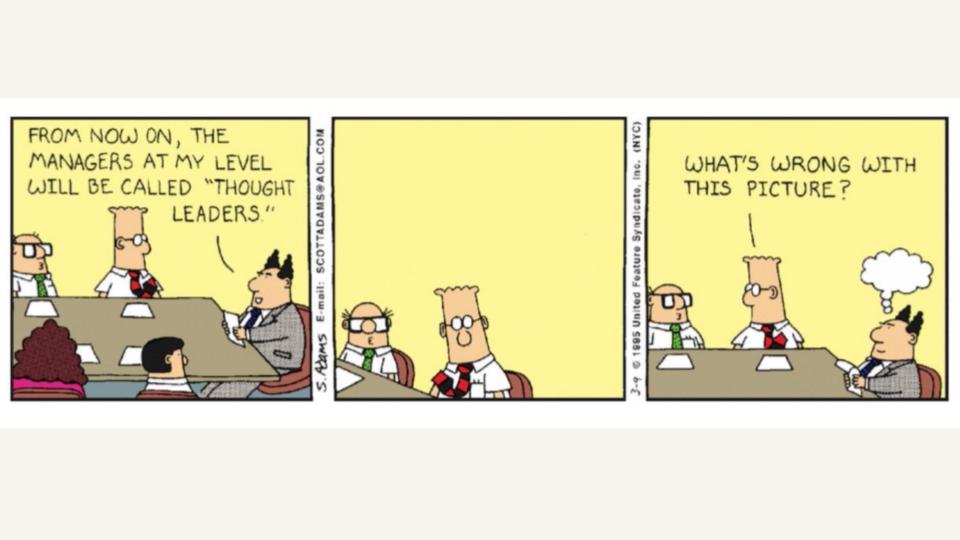
In today's digital landscape, everyone wants to be a thought leader. But as the Dilbert comic above humorously illustrates, simply declaring yourself a thought leader doesn't make it so. The real challenge lies in building genuine influence through expertise, authenticity, and strategic content creation.
We recently hosted a comprehensive presentation on the future of thought leadership, exploring what it truly means to be a thought leader in 2025. The insights shared below come from extensive research, expert interviews, and analysis of successful thought leaders across industries. Whether you're just starting your journey or looking to enhance your existing presence, this blueprint will help you navigate the evolving landscape of thought leadership.
The Challenge: Information Overload and Attention Scarcity #
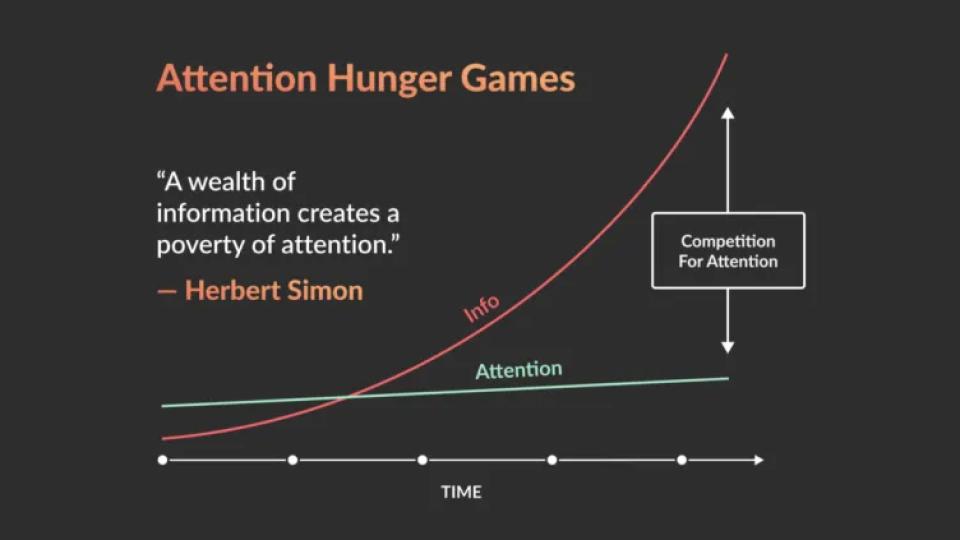
As Herbert Simon famously said, "A wealth of information creates a poverty of attention." In 2025, this challenge has only intensified. The gap between available information and human attention capacity continues to grow exponentially, making it increasingly difficult to cut through the noise.
"It's getting harder and harder to get people's attention. Marketing tactics like Google Ads and Facebook ads are becoming more competitive, and users are growing increasingly tired of traditional advertising. There's just so much noise out there. But people want to hear from people—they want to connect with authentic experts who can provide genuine insights and value."
Who Can Be a Thought Leader? #
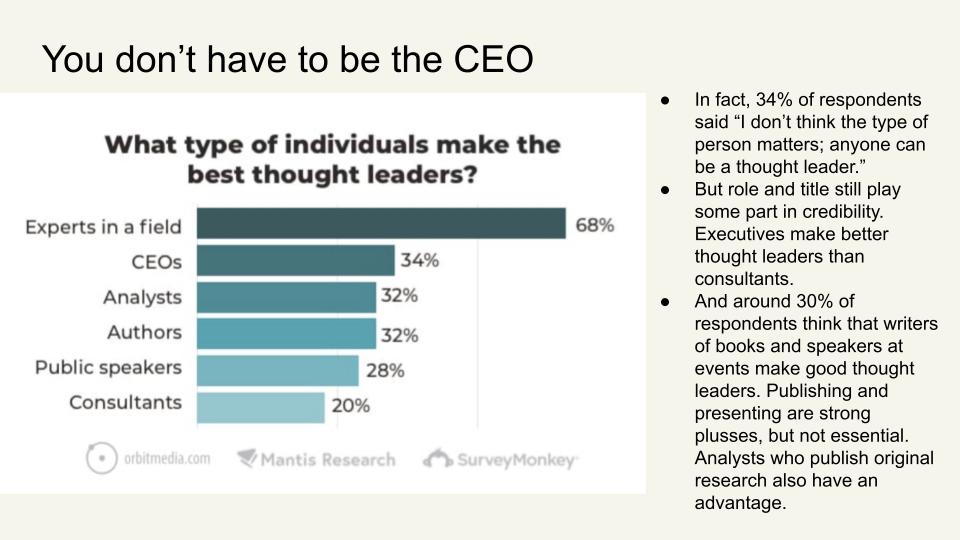
Research reveals that thought leadership isn't limited to CEOs. Here's what we found:
-
Expertise Matters Most (68%)
Being perceived as an expert in your field is the most important factor. This expertise can come from experience, knowledge, or unique insights that add value to your industry. -
Executive Experience Helps (34%)
While not required, having executive experience or being a CEO can help establish credibility. This background often provides valuable insights and a broader perspective. -
Professional Roles Add Value (32%)
Being an analyst or author can enhance your thought leadership position. These roles naturally lend themselves to sharing expertise and insights. -
Public Speaking Builds Presence (28%)
Experience as a public speaker helps you communicate your ideas effectively and build your reputation as a thought leader. -
Consulting Experience Counts (20%)
Working as a consultant can provide valuable insights and practical experience that strengthens your thought leadership position.
"You don't have to be the CEO. Over a third of respondents on the survey said they don't care what type of person you are. They think anyone could become a thought leader. That being said, there still are some nuances. So, as far as roles and titles, people that are an executive or have been an executive in the past are perceived more easily as a thought leader."
The key takeaway? You don't need to be a CEO, but you do need to be perceived as an expert in your field.
Earning Your Wings as a Thought Leader #

Just as the comic above shows, becoming a thought leader isn't about flapping your arms and hoping to fly—it's about building the right foundation, developing genuine expertise, and consistently delivering value to your audience. This journey requires dedication, strategy, and the right tools to help you soar.
"If you don't commit to thought leadership and building your personal brand long term, you won't get the results. It's like building a flywheel—it keeps building and building momentum over time. This is why we wanted to make it easier with AI, while still allowing you to build your presence authentically. In the end, you've got to earn your wings."
The Role of Social Media #
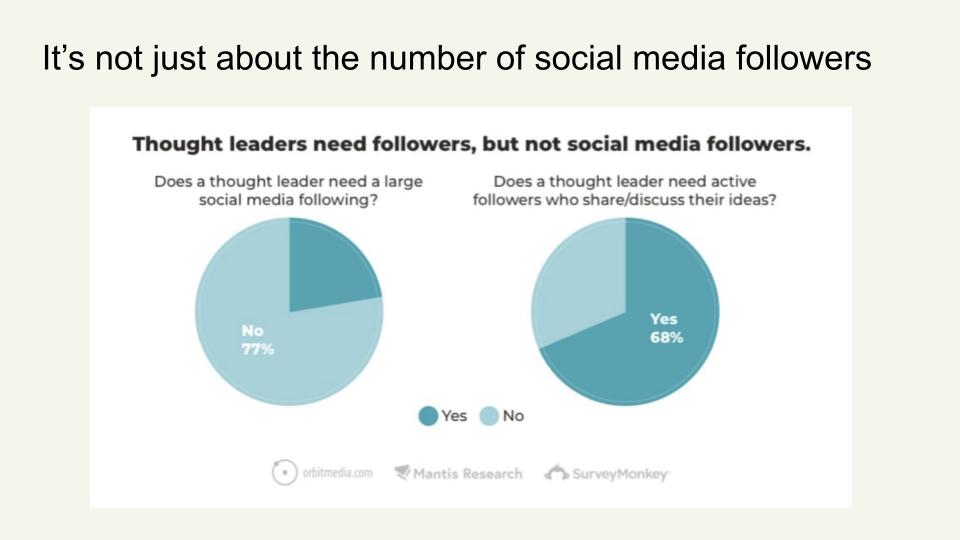
Research shows that thought leadership isn't about follower count:
-
Large Following Not Required (77%)
The size of your social media audience isn't the key to thought leadership success. What matters more is the quality and depth of your influence, not the sheer number of followers. -
Active Engagement Matters (68%)
Having followers who actively engage with, share, and discuss your ideas is far more valuable than a large passive audience. This engagement demonstrates the real impact of your thought leadership.
"77% of respondents said a large social media following isn't necessary for thought leadership. However, 70% emphasized the importance of having active followers who engage with and discuss your ideas."
Effective Content Types #
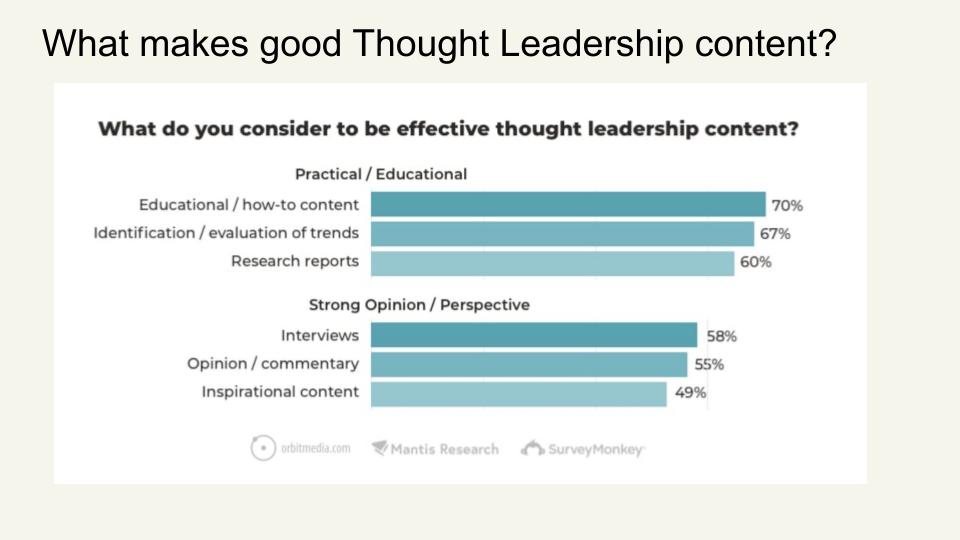
What makes for effective thought leadership content?
-
Practical Educational Content (70%)
Content that helps your audience learn and grow, including how-to guides, educational materials, trend analysis, and research reports. This type of content provides immediate value and actionable insights that your audience can apply. -
Strong Opinion Content (58%)
Content that shares your unique perspectives through interviews, commentary, and inspirational pieces. This helps establish your voice and position on important topics while engaging your audience in meaningful discussions.
"Two types of content emerged as most valuable: practical educational content—like how-to guides and trend analysis—and opinion-based content that provides fresh perspectives. People want actionable insights and well-reasoned viewpoints."
Essential Qualities of Modern Thought Leaders #
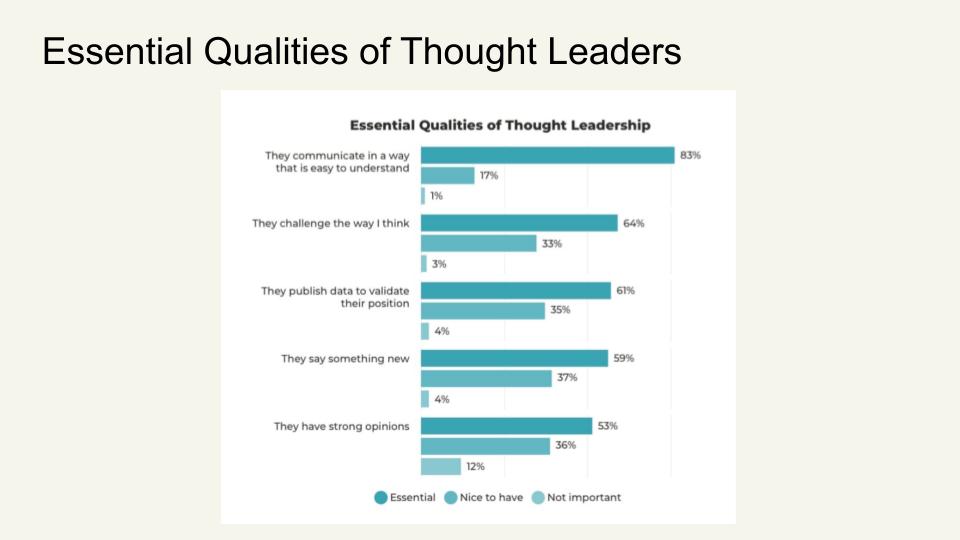
What makes a thought leader effective? Research shows these essential qualities:
-
Clear Communication (83%)
The ability to break down complex ideas into simple, engaging explanations that resonate with your audience. This includes using accessible language, creating visual content, and maintaining an engaging writing style that makes your message stick. -
Challenging Perspectives (64%)
Offering fresh viewpoints and innovative approaches that push your audience to think differently. This means presenting new ways of thinking about familiar topics and encouraging intellectual growth through unique insights. -
Data-Driven Insights (61%)
Supporting your positions with concrete evidence, research, and real-world examples. This builds credibility by showing that your ideas are grounded in solid data and practical experience. -
Original Ideas (59%)
Bringing unique perspectives and novel solutions to industry challenges. This involves developing fresh thinking that stands out from common industry narratives and offers new approaches to solving problems. -
Strong Opinions (53%)
Taking clear, confident stances on important issues while backing them up with well-reasoned arguments. This means being unafraid to express strong viewpoints while maintaining credibility through thoughtful analysis.
"83% of respondents said it's essential for thought leaders to communicate clearly and understandably. They're looking for someone who can simplify complex ideas, make content visual, and connect with their audience. This investment in clear communication delivers significant returns."
Nice-to-Have Qualities #
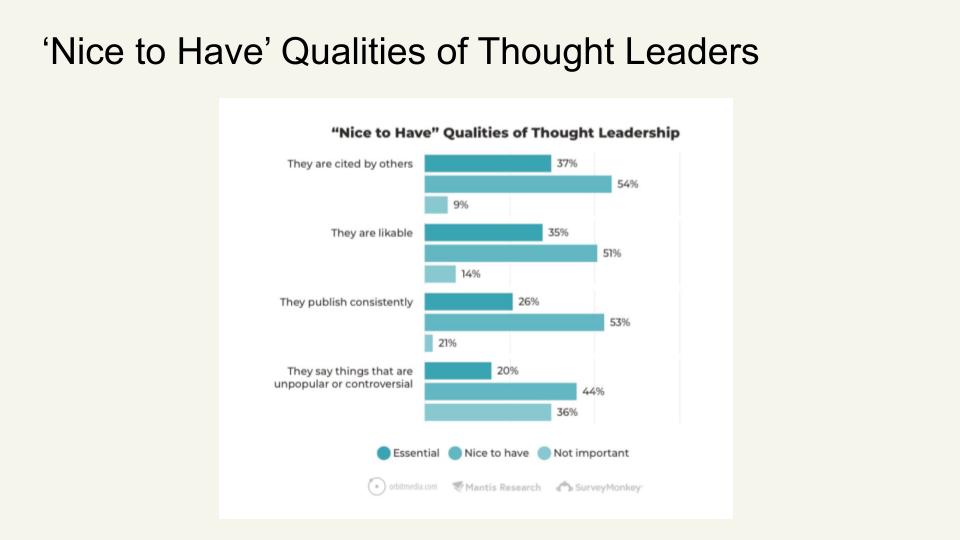
While not essential, these qualities can enhance your thought leadership:
-
Being Cited by Others (54%)
Having others reference your work builds credibility and amplifies your influence. It shows that your ideas are valuable enough to be shared and discussed by others in your field. -
Being Likable (51%)
While not the most critical factor, being approachable and relatable helps you connect with your audience. It makes your expertise more accessible and encourages engagement with your content. -
Publishing Consistently (53%)
Regular content creation helps maintain visibility and demonstrates commitment to your field. However, quality and relevance matter more than frequency alone. -
Saying Controversial Things (44%)
While some controversy can spark discussion, it's not a primary driver of thought leadership. Focus on well-reasoned, constructive viewpoints rather than controversy for its own sake.
Key Learnings from Thought Leadership Research #
Our comprehensive research reveals several critical insights about modern thought leadership. First, expertise and clear communication are paramount—83% of respondents emphasize the importance of breaking down complex ideas into accessible explanations. Second, while executive experience can help, it's not required; anyone can become a thought leader by demonstrating genuine expertise and value. Third, social media presence is about quality over quantity—77% say a large following isn't necessary, but 68% emphasize the importance of active engagement. Fourth, content should balance practical education (70%) with strong, well-reasoned opinions (58%). Finally, thought leadership is a long-term commitment that builds momentum over time, requiring consistent effort and authentic engagement with your audience.
The Thought Leadership Blueprint #
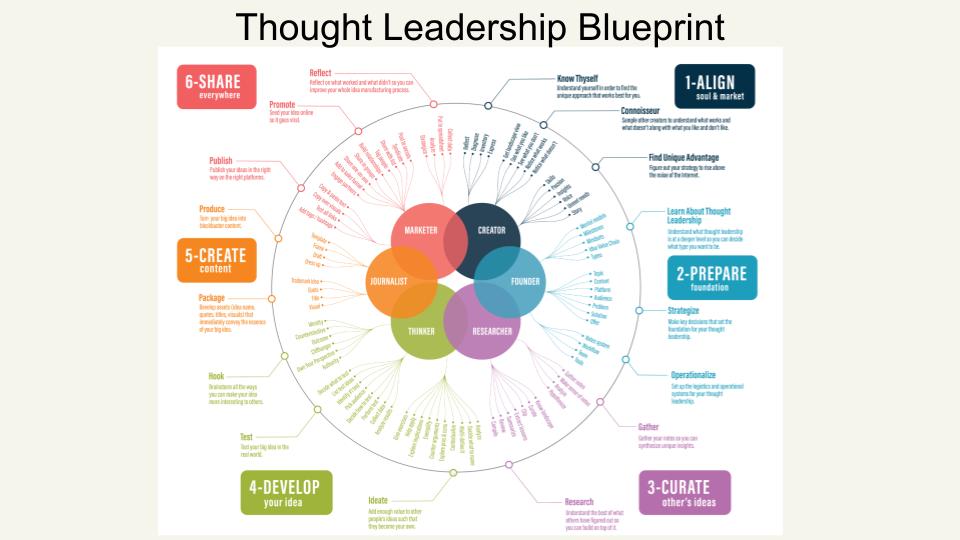
Now that we understand what makes an effective thought leader—from clear communication and strong opinions to the importance of expertise and engagement—it's time to put this knowledge into action. Research has led us to develop a comprehensive blueprint for building thought leadership. This six-step framework has been proven effective across various industries and experience levels.
Step 1: Align (Soul & Market) #
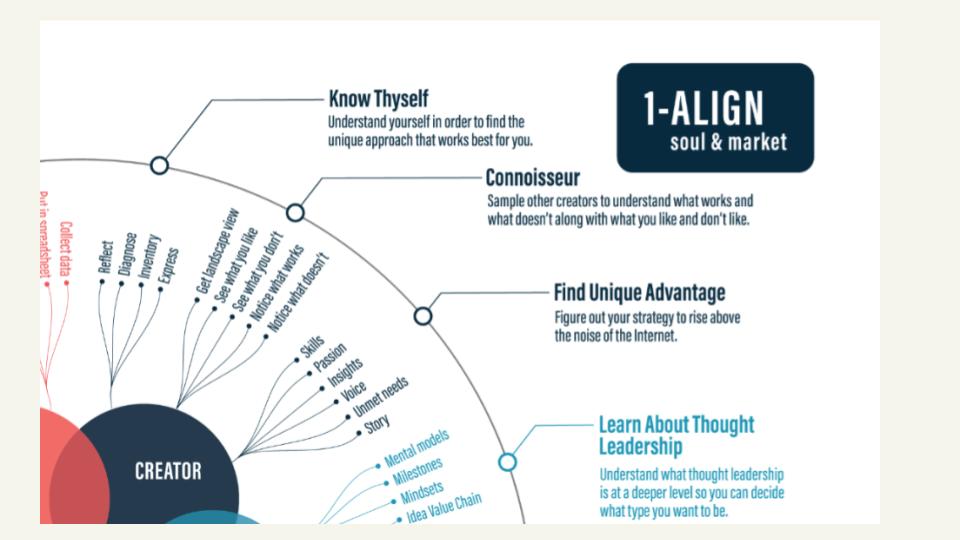
The foundation of successful thought leadership starts with alignment. Let's explore the three essential components:
-
Know Thyself
Understanding your core expertise, values, and unique perspective. This includes identifying your key strengths, defining your authentic voice, and clarifying what makes your insights valuable to others. -
Connoisseur
Becoming a student of your field by studying others' work. This involves analyzing successful thought leaders, understanding different approaches, and learning from both successes and failures in your industry. -
Find Unique Advantage
Discovering your distinctive position in the market. This means identifying gaps in current thinking, finding your unique angle, and developing a perspective that sets you apart from others in your field.
These three elements form the foundation for building your personal brand platform. By understanding yourself, learning from others, and finding your unique position, you'll be ready to create a compelling and authentic presence in your field.
The Personal Brand Platform #
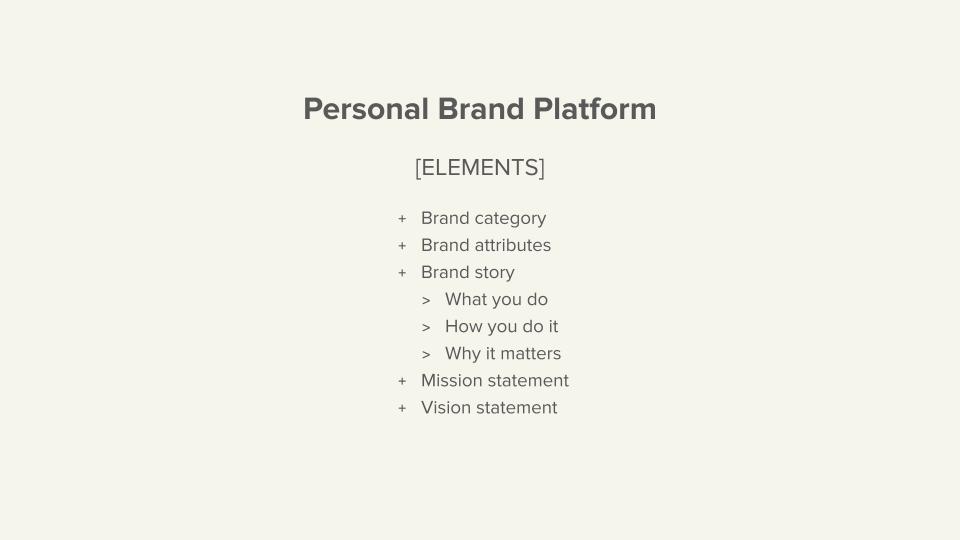
Your personal brand platform consists of five key components:
-
Category
Your category is the foundation of your thought leadership identity. It encompasses your area of expertise, market position, and unique space in your industry. This component defines where you fit in the market and helps your audience quickly understand your expertise and value proposition. -
Attributes
These defining features set you apart from others in your field. Your attributes include your key characteristics, core values, and distinctive qualities that make your brand memorable and help build trust with your audience. -
Story
Your story connects your past experiences with your current expertise. It weaves together your journey, approach, and impact to explain your unique perspective and why your insights matter to your audience. -
Mission
Your mission statement articulates your bigger purpose and the value you aim to create. It outlines your goals, purpose, and intended contribution to your field, guiding your content and engagement strategy. -
Vision
Your vision statement inspires and motivates both you and your audience. It captures your long-term aspirations, desired impact, and future direction, outlining where you're heading and the broader impact you hope to achieve.
"The personal brand platform is your strategic foundation for thought leadership. Each component—from your category to your vision—works together to create a cohesive and compelling presence. Your category defines your market position, attributes characterize your brand, story explains your journey, mission captures your purpose, and vision inspires your direction. This framework helps you maintain consistency while building authentic influence."
Step 2: Prepare (Foundation) #
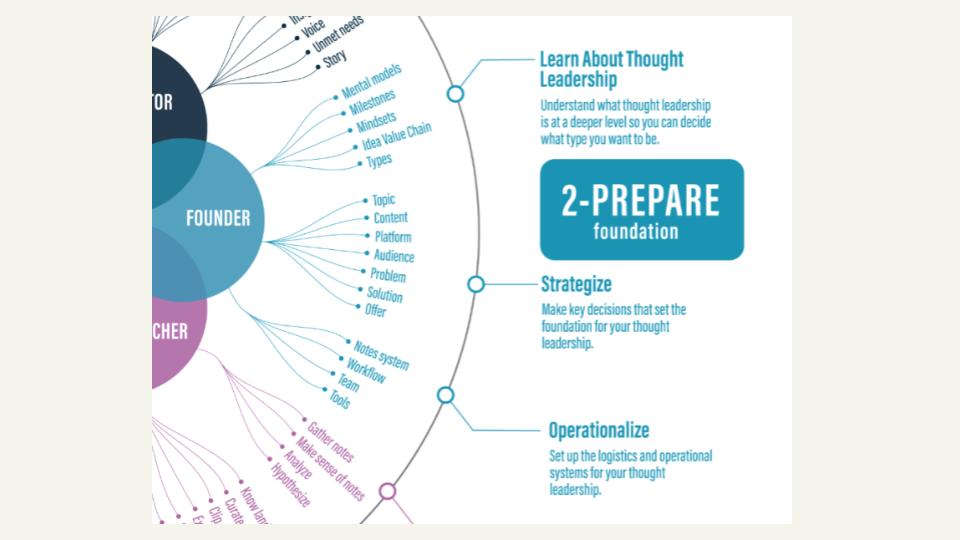
The foundation phase is about building the essential knowledge and systems needed for thought leadership success. This involves three key areas:
-
Learning About Thought Leadership
Understanding the principles, best practices, and current trends in thought leadership. This includes studying successful examples, learning from industry leaders, and staying updated on emerging strategies. -
Developing Your Strategy
Creating a comprehensive plan that aligns with your personal brand platform. This includes setting clear goals, defining your target audience, establishing your content themes, and planning your content calendar. -
Setting Up Your Operational Workflow
Building the systems and processes that will make your thought leadership sustainable. This includes establishing content creation workflows, setting up publishing schedules, and creating systems for research, ideation, and content development.
Step 3: Curate (Others' Ideas) #
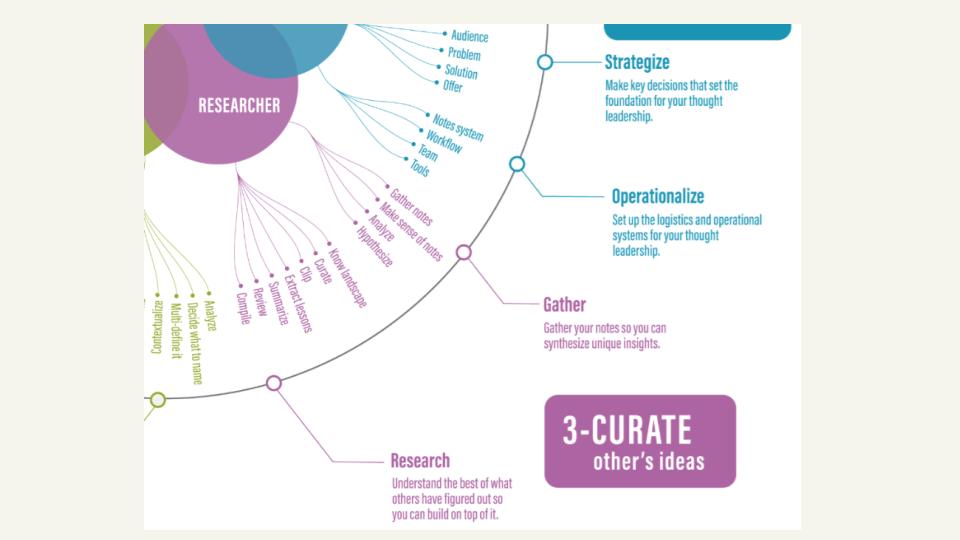
The curation phase focuses on gathering and analyzing existing knowledge in your field. Here's how to build your knowledge foundation:
-
Gathering Notes
Collecting relevant information, research, and insights from various sources. This includes industry reports, academic papers, news articles, and expert opinions that inform your thinking. -
Synthesizing Insights
Analyzing and connecting different pieces of information to identify patterns and trends. This process helps you develop a deeper understanding of your field and identify opportunities for unique perspectives. -
Researching Existing Knowledge
Building a comprehensive understanding of current thinking in your area. This includes studying competitor content, industry discussions, and emerging topics to ensure your ideas are relevant and timely.
Step 4: Develop (Your Ideas) #
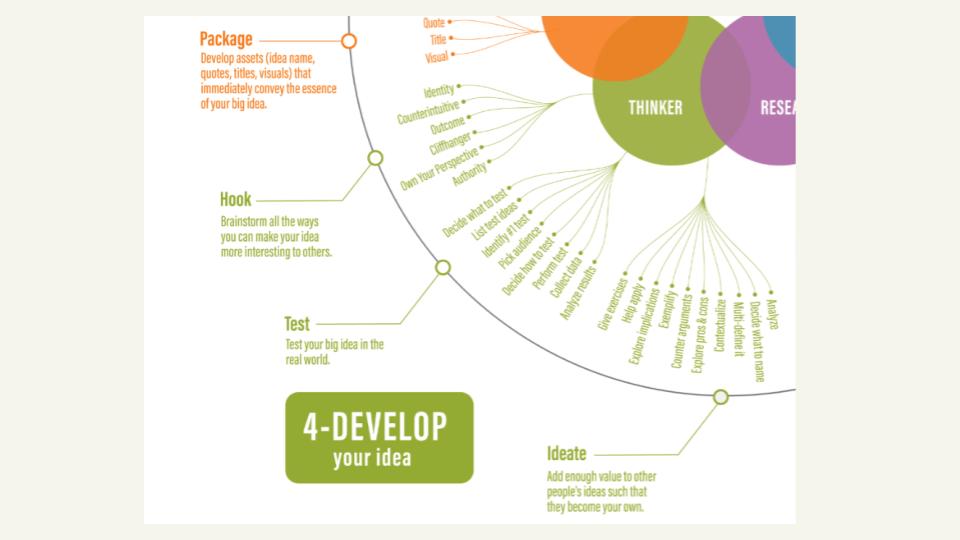
The development phase transforms your research into unique insights. Let's explore the key components:
-
Hooking Your Ideas
Creating compelling angles and narratives that capture attention. This includes developing unique perspectives, identifying surprising connections, and finding fresh ways to present familiar concepts. -
Testing in the Real World
Validating your ideas through practical application and feedback. This includes sharing early concepts with trusted peers, gathering audience reactions, and refining based on real-world responses. -
Ideating and Refining
Continuously developing and improving your ideas. This process involves brainstorming variations, incorporating feedback, and polishing your concepts until they're ready for broader sharing.
Step 5: Create (Content) #
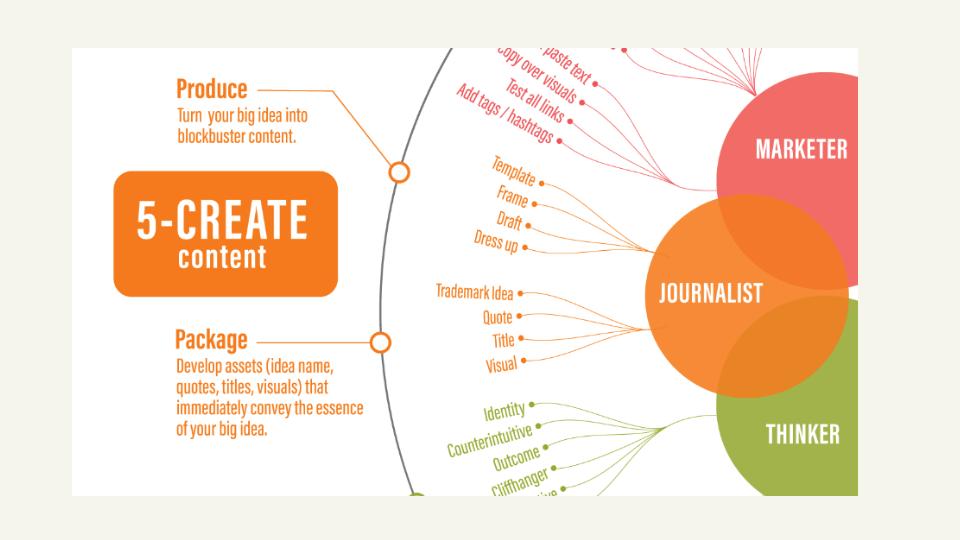
The creation phase brings your ideas to life through three essential elements:
-
Producing Content
Creating high-quality content that effectively communicates your ideas. This includes writing articles, creating presentations, developing visual content, and crafting engaging narratives. -
Packaging Your Ideas
Presenting your content in formats that resonate with your audience. This includes choosing appropriate mediums, structuring information effectively, and ensuring your message is clear and compelling. -
Developing Supporting Assets
Creating additional materials that enhance your main content. This includes visual aids, data visualizations, case studies, and examples that reinforce your key points.
Step 6: Share (With Everyone) #
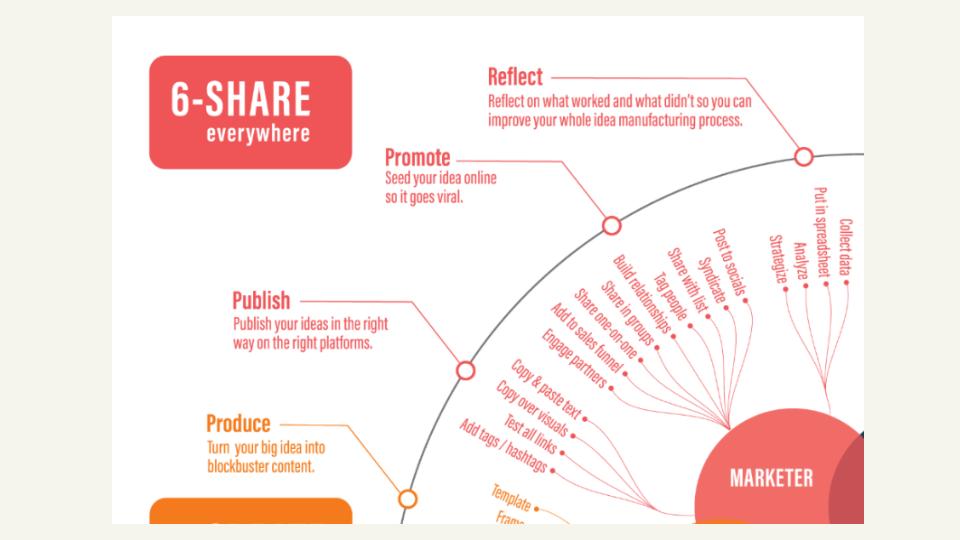
The sharing phase maximizes your content's impact through these critical components:
-
Publishing Strategically
Releasing your content at the right time and in the right places. This includes choosing optimal platforms, timing your releases, and ensuring your content reaches your target audience effectively. -
Promoting Effectively
Amplifying your content through various channels. This includes social media sharing, email distribution, networking, and leveraging existing relationships to expand your reach. -
Reflecting and Improving
Analyzing performance and refining your approach. This includes tracking engagement metrics, gathering feedback, and using insights to improve future content and sharing strategies.
Next-Level Thought Leadership #
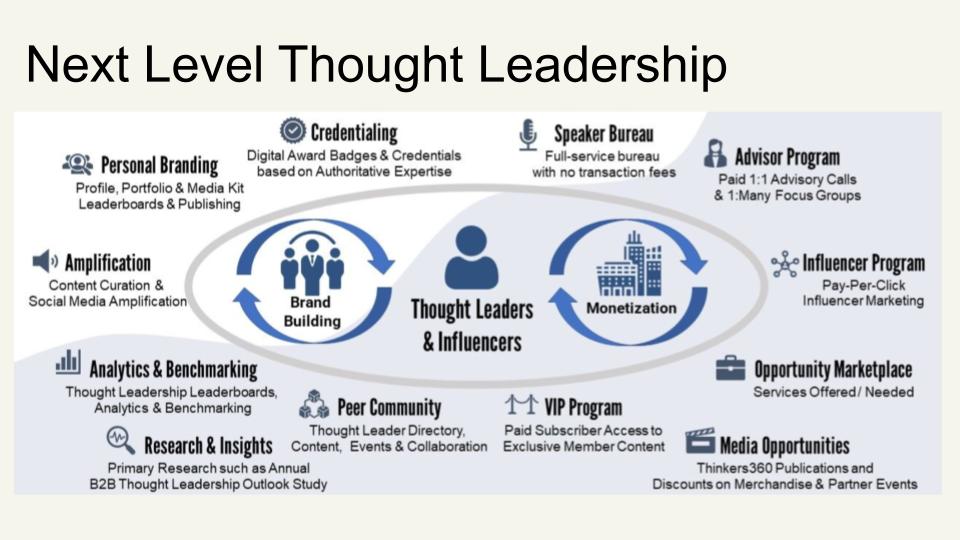
Beyond the basic blueprint, consider these advanced strategies:
-
Personal Branding
Developing a distinctive and memorable personal brand that resonates with your audience. This includes creating a consistent visual identity, tone of voice, and messaging that reflects your unique value proposition. -
Credentialing
Building and showcasing your expertise through certifications, awards, and recognition. This includes speaking engagements, media appearances, and industry acknowledgments that validate your authority. -
Speaker Bureau
Expanding your reach through professional speaking engagements. This involves developing compelling presentations, connecting with event organizers, and delivering impactful talks that showcase your expertise. -
Advisory Services
Offering strategic guidance to organizations and individuals. This includes consulting work, advisory board positions, and mentorship programs that leverage your expertise for direct impact. -
Influencer Marketing
Collaborating with other thought leaders and brands to amplify your reach. This involves strategic partnerships, co-created content, and cross-promotion that expands your influence. -
Media Opportunities
Leveraging traditional and digital media to share your insights. This includes guest articles, podcast appearances, interviews, and media coverage that increase your visibility. -
VIP Programs
Creating exclusive experiences for your most engaged followers. This includes premium content, private communities, and special access that deepens relationships with your core audience. -
Community Building
Fostering engaged communities around your ideas. This involves creating spaces for discussion, facilitating connections, and building networks that amplify your impact. -
Research Publishing
Producing original research and insights that advance your field. This includes conducting studies, publishing reports, and sharing findings that establish you as a leading voice. -
Analytics and Benchmarking
Measuring and optimizing your thought leadership impact. This involves tracking key metrics, analyzing performance data, and using insights to continuously improve your strategy.
While these advanced strategies can significantly enhance your thought leadership journey, implementing them all can be challenging. This is where technology comes in. By leveraging AI-powered tools, you can streamline these processes, maintain consistency, and scale your impact more effectively. Let's explore how Spark AI can help you execute this blueprint and take your thought leadership to the next level.
Spark AI: Your Thought Leadership Copilot #
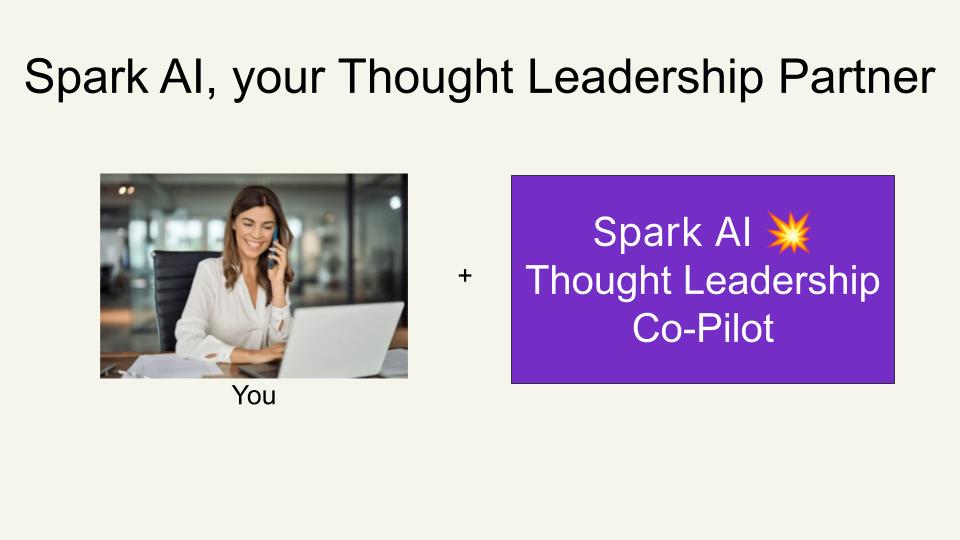
The journey to becoming a thought leader in 2025 doesn't have to be overwhelming. With Spark AI as your thought leadership copilot, you can streamline your entire process.
"Spark AI serves as your thought leadership copilot, working with you through weekly 15-minute conversations. Whether through voice calls or text, it helps you develop and share your expertise consistently."
How Spark AI Works #
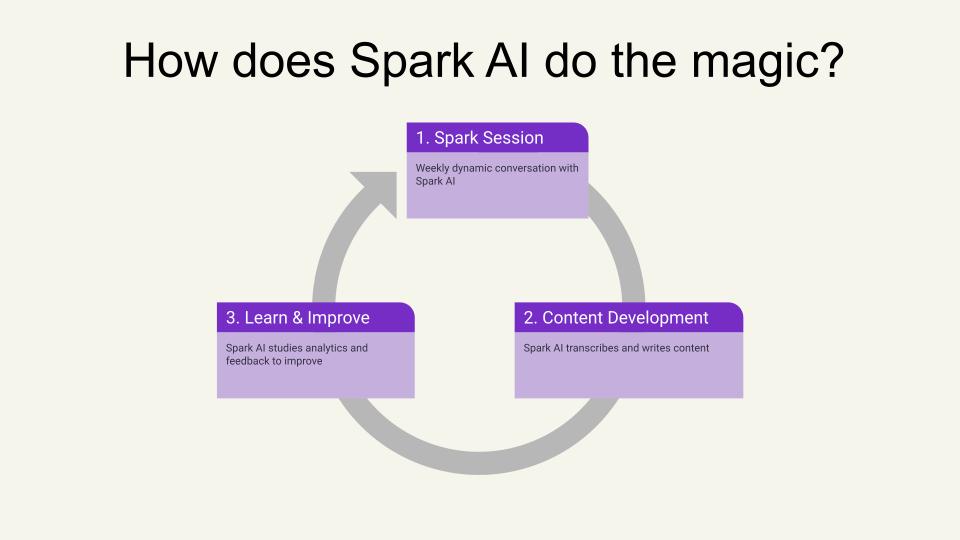
-
Weekly Dynamic Conversations
Engage in focused, efficient conversations that capture your expertise. These 15-minute sessions are powered by AI that comes prepared with market knowledge and adapts to your specific goals and audience preferences, making every interaction productive and purposeful. -
Content Development
Transform your insights into polished content ready for your audience. The system transcribes your conversations, creates engaging content that maintains your voice, and handles the publishing process, allowing you to focus on sharing your expertise rather than content creation. -
Continuous Learning
Benefit from an AI system that evolves with you. By studying analytics, incorporating feedback, and learning from each interaction, the platform continuously refines its approach to better serve your thought leadership goals and audience needs.
"In that one fifteen-minute conversation, you will engage in an interview with Spark AI with the Spark AI interviewer. Can be a voice call. So, on your on your mobile phone, You're engaged in a in this fifty-minute conversation with Spark AI. If you prefer texting, you can also text to Spark AI."
Real Results from Spark AI Users #
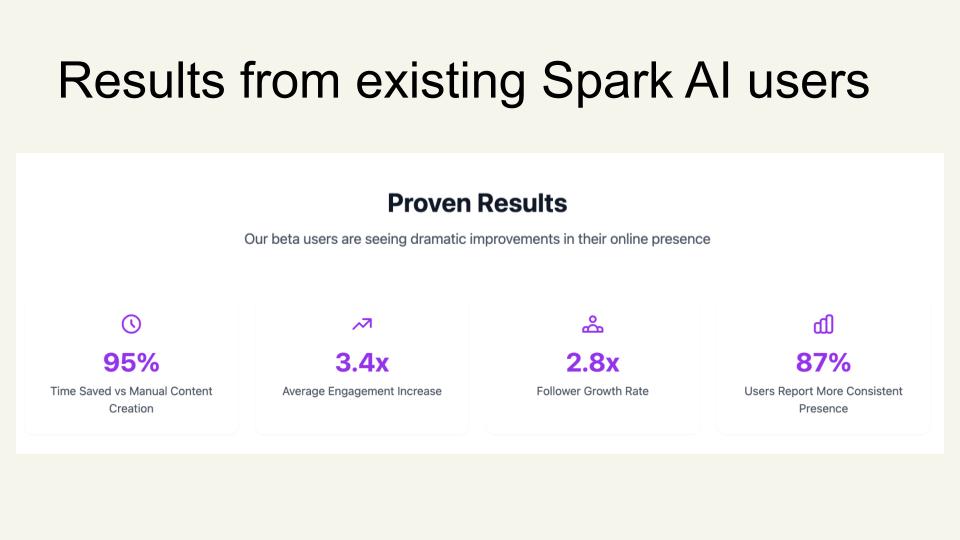
Our users are experiencing transformative results across multiple dimensions. On the efficiency front, they're seeing a remarkable 95% reduction in content creation time through automated research, curation, and streamlined publishing processes. Engagement metrics have soared, with users averaging a 3.4x increase in audience engagement while maintaining a more consistent online presence. Perhaps most importantly, 87% of users report achieving sustained consistency in their thought leadership efforts, with regular content updates and maintained audience engagement—a critical factor for long-term success.
Why People Choose Spark AI #
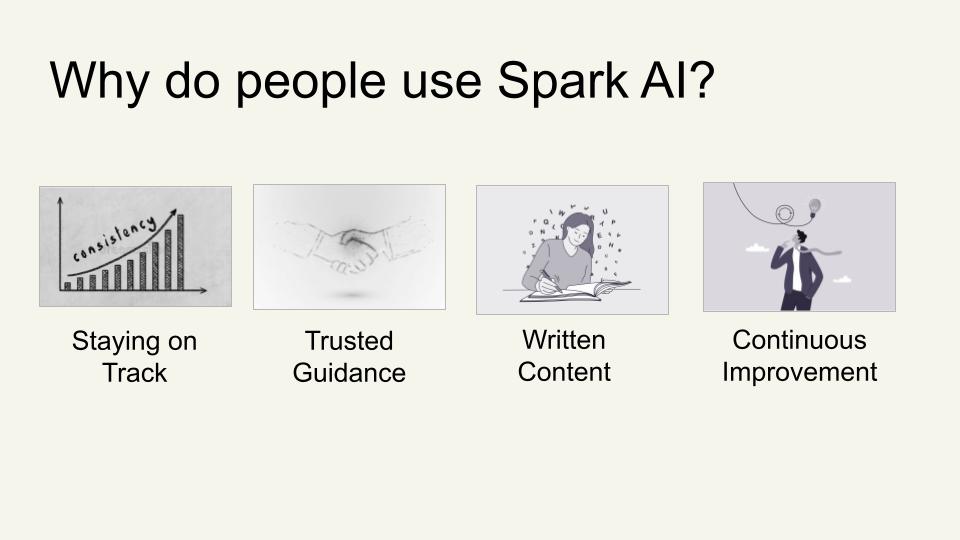
Users consistently highlight four key benefits that make Spark AI essential to their thought leadership journey. First, the platform helps them stay on track with consistent content creation, regular engagement, and clear direction for their thought leadership efforts. They also value the trusted guidance provided through AI-powered insights, comprehensive market knowledge, and strategic direction. The quality of written content stands out, with professional-grade materials that maintain a consistent voice and are ready to publish. Finally, users appreciate the continuous improvement aspect, where the system learns from analytics, adapts to feedback, and evolves its strategy to better serve their needs over time.
Start Your Journey Today #
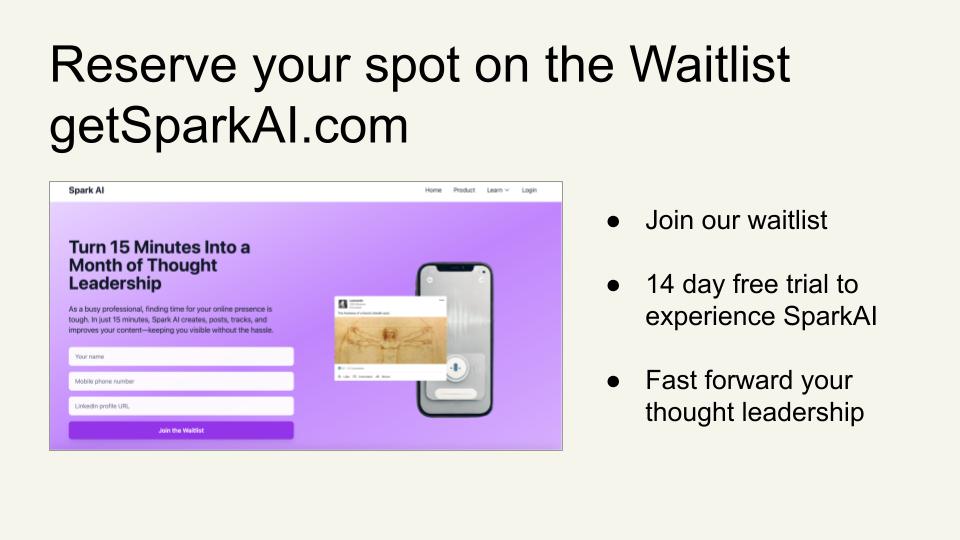
"Join our waitlist to reserve your spot. We're accepting new users in cohorts, with priority given to early registrants."
Ready to transform your thought leadership journey? Join our waitlist and be among the first to experience the future of thought leadership with AI. With a 30-day free trial, you can see firsthand how Spark AI can help you build your influence and impact in 2025.
Conclusion #
Thought leadership in 2025 is about more than just sharing content—it's about building genuine influence through expertise, authenticity, and strategic use of technology. Whether you're just starting your journey or looking to scale your existing presence, the combination of proven strategies and AI-powered tools can help you achieve your goals more efficiently than ever before.
Ready to start your thought leadership journey? Join our waitlist and be among the first to experience the future of thought leadership with AI.
Related Tools
Take your thought leadership to the next level with these free Spark AI tools:
- Thought Leadership Mini-Plan - Build a custom plan from your LinkedIn profile with AI.
- Explore All Free Tools - Discover more ways to amplify your voice.
